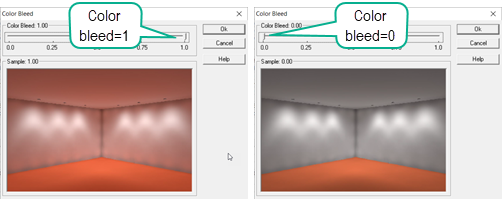
![]()
Color Bleed - Concepts
Color Bleed is real, physically observable phenomenon that occurs when strongly saturated colors are reflected to adjacent surfaces. Take a brightly colored surface (like red construction paper) and hold it horizontally next to any white wall. You'll observe the light reflected from the red construction paper as a red blotch on the wall. The red blotch is the "color bleed".
Computer generated environments with strong colors (e.g., a bright green carpet) tend to produce a strong color cast on nearby surfaces in the rendered environments. In real life, our eyes and brain compensate for the color cast and we would see the walls and ceiling as white. Color photographs and video displays do not compensate for the color cast automatically, and the rendered environment appears overly saturated in this manner.
The Color Bleed scale simulates human color vision adaptation. It is applied on an individual surface basis, and should be applied to surfaces with strongly saturated color (the emitters).

Technical Details
Color Bleed Scale is applied by decreasing the amount of spectral color in the surface, while maintaining the same grayscale color reflectance. The following example illustrates a red carpet with a Color Bleed Scale of 0.25 applied:
Carpet Spectral reflectance (RGB values) - R = 230, G = 13, B = 13. The saturation ratio of each color is: R = 0.9 (230/255), G = 0.05 (13/255), B = 0.05 (13/255)
Carpet Grayscale reflectance Value:
- Reflectance = 0.21R + 0.72G + 0.07B
- Carpet Reflectance = 0.21*(230/255) + 0.72*(13/255) + 0.07*(13/255) = 0.23 (23%)
Color Bleed Scale = 1 (No Color Bleed Scale)
- Luminaires emit white light
- Carpet reflects red light (R = 230, G = 13, B = 13)
- Ceiling and walls receive red light
Color Bleed Scale = 0.25
- Luminaires emit white light
- Carpet reflects pinkish white light
- Each individual carpet color is scaled:
- Rscaled = Grayscale reflectance (0.23*255 = 59) + Scaled Red Reflectance (0.25 * (230 - 59) = 102
- Gscaled = Grayscale reflectance (0.23*255 = 59) + Scaled Green Reflectance (0.25 * (13 - 59) = 48
- Bscaled = Grayscale reflectance (0.23*255 = 59) + Scaled Blue Reflectance (0.25 * 13 - 59) = 48
- Carpet Grayscale Reflectance remains the same = 0.21*(102/255) + 0.72*(48/255) + 0.07*(48/255) = 0.23 (23%)